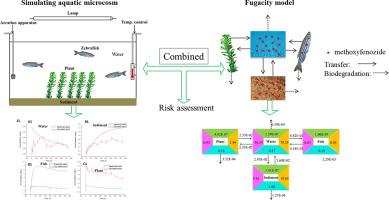Science of the Total Environment ( IF 8.2 ) Pub Date : 2020-09-24 , DOI: 10.1016/j.scitotenv.2020.142482 Yajie Chen , Xingang Liu , Fengshou Dong , Jun Xu , Xiaohu Wu , Yongquan Zheng

|
Methoxyfenozide is widely employed in paddy land and can flow out into the aquatic environment. The present study combines two approaches, namely, an aquatic microcosm simulation experiment and a multimedia fugacity model, to study the fate and distribution of methoxyfenozide in an aquatic microcosm containing water, sediment, aquatic plants, and zebrafish. The model results indicated that the simulated concentrations agreed with the observed values within one order of magnitude. The degradation rate was less than 7.0% in the three types of aquatic microcosms at 740 h in the model. Methoxyfenozide exhibited very high persistence in the aquatic microcosm. Water played a key role in the fate of methoxyfenozide, acting as a sink in the simulated aquatic environment, followed by sediment. Only approximately 2% of methoxyfenozide entered the organisms (zebrafish and Egeria densa Planch). Methoxyfenozide underwent a significant transport process between the water and sediment. The applications of multimedia fugacity models are useful for understanding the behaviors, fate, and transport of pesticides after their release into the environment and to facilitate risk assessment and management activities.
中文翻译:

使用多媒体逸度模型表征水生植物-鱼类沉积物缩影中甲氧基苯甲酰胺的命运和分布
甲氧芬尼治广泛用于稻田中,并可流入水生环境。本研究结合了两种方法,即水生微观模拟实验和多媒体逸度模型,以研究甲氧基苯甲酰胺在包含水,沉积物,水生植物和斑马鱼的水生微观世界中的命运和分布。模型结果表明,模拟浓度与观察值在一个数量级内一致。该模型在740 h时,三种水生微观世界的降解率均低于7.0%。甲氧芬尼嗪在水生微观世界中显示出很高的持久性。水在甲氧芬诺的命运中起关键作用,在模拟的水生环境中充当汇,随后是沉积物。Egeria densa Planch)。甲氧芬尼特在水和沉积物之间经历了重要的运输过程。多媒体逸度模型的应用对于了解农药释放到环境中后的行为,命运和运输方式以及促进风险评估和管理活动很有用。































 京公网安备 11010802027423号
京公网安备 11010802027423号